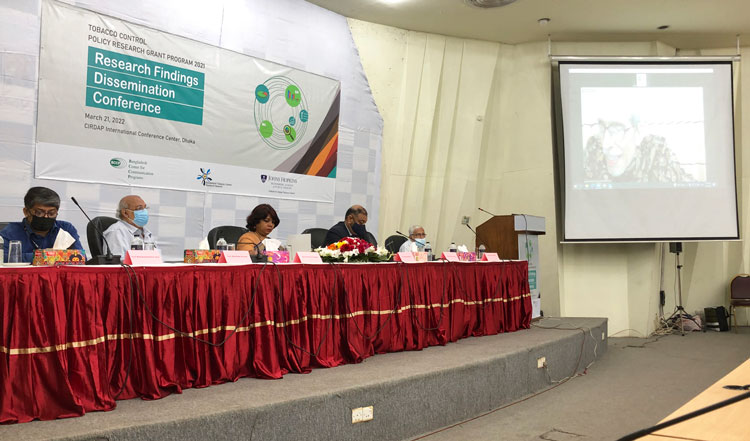Research Findings Dissemination Conference 2022

A day-long research findings dissemination conference was held on March 21, 2022 at CIRDAP International Conference Center, Dhaka where the research findings of the Tobacco Control Policy Research Grant Program 2021, funded by BCCP and Johns Hopkins Bloomberg School of Public Health, were presented to the audiences. Apart from the research findings dissemination program, a poster session was also held at this conference where research findings of other research studies were presented through a poster presentation session. Research findings of 12 research studies were presented to the audience during the poster presentation session. Besides, these 12 research studies also make their way into a dissemination booklet, jointly published by Bangladesh Center for Communication Program (BCCP), Bangladesh Tobacco Control Research Network (BTCRN), and Johns Hopkins Bloomberg School of Public Health (JHBSPH), where abstracts of these 12 research studies were published alongside the 7 research studies which were conducted under the BCCP-JHBSPH program. Among these 12 research studies, UBINIG & TABINAJ-led research study titled ‘Standard Packaging for Smokeless Tobacco Products: A Crucial Tobacco Control Measure to Save the Poor and Rural Women’ was able to make its room in the dissemination booklet as well as in the poster presentation session. On behalf of UBINIG & TABINAJ, Sayyida Akhter, first author of the aforementioned research study, and Hasanul Hasib Al Galib, co-author of this research study, participated in this program. This day-long research findings dissemination conference was held in two sessions: scientific session 1 and scientific session 2. The scientific session 1 was chaired by National Professor Dr. Brig. (Rtd.) Abdul Malik, President, National Heart Foundation of Bangladesh, and Advisor, Bangladesh Tobacco Control Research Network. Ms. Kazi Zebunnessa Begum, Additional Secretary, (WH-wing), Health Services Division, Ministry of Health and Family Welfare was the chief guest of this session. Besides, Prof. Dr. Shah Monir Hossain, Former Director General, DGHS; Dr. Bardan Jung Rana, WHO Representative to Bangladesh; Prof. Dr. Md. Ruhul Amin, Director, Bangladesh Medical Research Council (BMRC); Prof. Dr. Mohammad Robed Amin, Line Director, Non-Communicable Diseases Control, Directorate General of Health Services; and Dr. Joanna Cohen, Director, Institute for Global Tobacco Control, Maryland, USA were present at this session as the Guests of Honor. Dr. Cohen joined the program and delivered her speech virtually. The scientific session 2 was chaired by Prof. Nawzia Yasmin, President, BTCRN, and Pro-Vice Chancellor, State University of Bangladesh. Mr. Hossain Ali Khondoker, Coordinator, NTCC, was the chief guest for scientific session 2. Mr. Md. Shafiqul Islam, Head of Programs, Vital Strategies; Mr. Md. Mostafizur Rahman, Lead Policy Advisor, CTFK, Bangladesh; Dr. Sadhana Bhagwat, Team Leader, (NDC and Mental Health), WHO Bangladesh; Mr. Syed Mahbubul Alam Tahin, Technical Advisor, The Union; and Ms. Sejal Saraf, Senior Research Program Coordinator, IGTC were present in the scientific session 2 as the Guests of Honor.
During the poster presentation session, Sayyida Akhter, Director of UBINIG and Convener of TABINAJ, spoke to the inquisitive audiences about her research study and focused on various crucial findings of this study. Dr. Shafiun Shimul, Associate Professor, Health Economics at University of Dhaka was present at this time as the Chairperson of the poster session. Dr. Sheikh Mohammad Mahbubus Sobhan, Registrar (Clinical Research), National Heart Foundation Hospital and Research Institute was also present during the poster session as the Co-Chairperson of this session.
Findings of UBINIG & TABINAJ-led Research Study
To assess the current situation of the packaging of the SLT products and focus on the role of standard packaging as a substantial tobacco control measure, UBINIG & TABINAJ conducted a research titled ‘Standard Packaging for Smokeless Tobacco Products: A Crucial Tobacco Control Measure to Save the Poor and Rural Women’ in 2019-2020.
For this research study, UBINIG collected 1271 Zarda containers from 64 districts of the country during the period 2019-2020. Secondary data were collected from various sources and KII and FGD were conducted for analyzing the data.
From the UBINIG study, it came out that currently Zarda and Gul products are being marketed in 45 and 2 different sizes of containers respectively whereas Sadapata is being sold without any packaging. There is no GHW in 33% of the containers; 40% have GHW but not in the proportion stipulated in the law. Moreover, GHWs are often placed in such a place of the packet that they may be concealed or damaged when opening the pack. Under the tobacco control law of Bangladesh, constituents and emissions disclosures are not required though Article 10 of WHO FCTC requires such disclosures. In many cases, the packaging of SLT products does not contain the required information such as production and expiry dates, MRP, etc. whereas the owner’s photo, or other attractive pictures and provocative messages are often found to be portrayed vividly. The materials for packaging the SLT products include low-grade tin, plastic and polythene.

On the basis of these findings, UBINIG & TABINAJ have proposed that loose selling of Sadapata be prohibited and it should be sold in 50g pack. For Zarda and Gul, 50g and 20g weight have been proposed respectively as the standard weight for packaging these products. A specific size has also been suggested for the Zarda and Gul container. For 50g Zarda container, standard height has been set as 10cm and diameter 5.6cm. For Gul container, standard height has been set as 5.3cm and diameter 4.5cm. This study has proposed that round-shaped container made with food-grade, bio-degradable tin or plastic material should be used for packaging the Zarda and Gul products while food-grade paper sachet should be used for packaging Sadapata.
Besides these specific recommendations about standard packaging, this research study has also put forward some suggestions, asking for changes at the policy-level, such as, amending the existing tobacco control law to facilitate standard packaging; utilizing the full potential of the existing laws, policies and notices; and coordination between various stakeholders such as National Tobacco Control Cell, Ministry of Industry, Ministry of Commerce, and Ministry of Environment, Forest and Climate Change.
